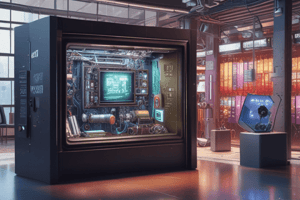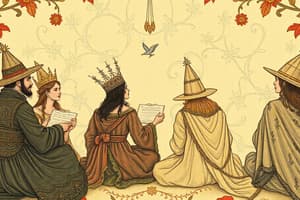Podcast
Questions and Answers
Which of the following is NOT one of the 21st-century skills mentioned in the curriculum?
Which of the following is NOT one of the 21st-century skills mentioned in the curriculum?
- Memorization (correct)
- Collaboration
- Problem-solving
- Communication
What is the main purpose of the "Red Hat" in the 6 Hats of Thinking framework?
What is the main purpose of the "Red Hat" in the 6 Hats of Thinking framework?
To explore emotions and gut feelings related to the problem.
Which of the following questions is associated with the "Black Hat" in the 6 Hats of Thinking?
Which of the following questions is associated with the "Black Hat" in the 6 Hats of Thinking?
- What are the long-term benefits of this action?
- What is the best way to approach the problem?
- What do we know about this issue?
- What are the potential risks and consequences? (correct)
What is the primary goal of the "Green Hat" in the 6 Hats of Thinking?
What is the primary goal of the "Green Hat" in the 6 Hats of Thinking?
The "White Hat" in the 6 Hats of Thinking is focused on gathering facts and data.
The "White Hat" in the 6 Hats of Thinking is focused on gathering facts and data.
Which of the following is NOT part of the UBD (Understanding by Design) framework's Stage 1?
Which of the following is NOT part of the UBD (Understanding by Design) framework's Stage 1?
In UBD's Stage 1, what is meant by the term "Challenging Limitations"?
In UBD's Stage 1, what is meant by the term "Challenging Limitations"?
Which of the following is NOT a component of the "Mastery Learning" instructional strategy?
Which of the following is NOT a component of the "Mastery Learning" instructional strategy?
Which of the following components is NOT included in the "Direct Instruction" strategy?
Which of the following components is NOT included in the "Direct Instruction" strategy?
What is the purpose of the Anticipatory Set in the "Guided Instruction" strategy?
What is the purpose of the Anticipatory Set in the "Guided Instruction" strategy?
In UBD's Stage 2, the "Transfer" component focuses on assessing how well students can apply their learning in new situations.
In UBD's Stage 2, the "Transfer" component focuses on assessing how well students can apply their learning in new situations.
Which of the following are considered key components of a curriculum?
Which of the following are considered key components of a curriculum?
According to the progressivist school of curriculum, what is its primary purpose?
According to the progressivist school of curriculum, what is its primary purpose?
A curriculum is simply a static list of subjects that students are expected to learn.
A curriculum is simply a static list of subjects that students are expected to learn.
The hidden curriculum refers to:
The hidden curriculum refers to:
What is the main purpose of professional development for educators in curriculum implementation?
What is the main purpose of professional development for educators in curriculum implementation?
What is the focus of a subject-centered curriculum?
What is the focus of a subject-centered curriculum?
What is an example of a pre-planning decision that a teacher should make?
What is an example of a pre-planning decision that a teacher should make?
What is the primary goal of teacher planning?
What is the primary goal of teacher planning?
How does technology integration enhance the learning experience for students?
How does technology integration enhance the learning experience for students?
Why is it important for educators to gather and respond to student feedback?
Why is it important for educators to gather and respond to student feedback?
What are the key characteristics of the learner-centered mode of curriculum design?
What are the key characteristics of the learner-centered mode of curriculum design?
Match the 6 Hats of Thinking with their corresponding colors:
Match the 6 Hats of Thinking with their corresponding colors:
What is stage 1 of UBD?
What is stage 1 of UBD?
What are the essential questions to ponder in UBD stage 1?
What are the essential questions to ponder in UBD stage 1?
What is the primary purpose of the Green Hat in the Six Thinking Hats method?
What is the primary purpose of the Green Hat in the Six Thinking Hats method?
What is the main focus of the Blue Hat in the Six Thinking Hats method?
What is the main focus of the Blue Hat in the Six Thinking Hats method?
Flashcards
Objectives
Objectives
Specific, measurable, achievable, relevant, and time-bound statements of what students will be able to do by the end of a lesson or unit.
Learning Outcomes
Learning Outcomes
Broad statements describing what students will understand or be able to do after a lesson or unit. They are often more general than objectives.
21st Century Skills
21st Century Skills
Essential skills for success in the modern world, including cognitive, interpersonal, and intrapersonal skills.
6 Hats of Thinking
6 Hats of Thinking
Signup and view all the flashcards
Red Hat
Red Hat
Signup and view all the flashcards
Black Hat
Black Hat
Signup and view all the flashcards
White Hat
White Hat
Signup and view all the flashcards
Yellow Hat
Yellow Hat
Signup and view all the flashcards
Green Hat
Green Hat
Signup and view all the flashcards
Blue Hat
Blue Hat
Signup and view all the flashcards
UBD Stage 1
UBD Stage 1
Signup and view all the flashcards
Oil Spill
Oil Spill
Signup and view all the flashcards
Blooms Taxonomy
Blooms Taxonomy
Signup and view all the flashcards
5Es Model
5Es Model
Signup and view all the flashcards
Transfer
Transfer
Signup and view all the flashcards
Meaning
Meaning
Signup and view all the flashcards
Essential Questions
Essential Questions
Signup and view all the flashcards
Limitations
Limitations
Signup and view all the flashcards
Intrinsic Factors
Intrinsic Factors
Signup and view all the flashcards
Extrinsic Factors
Extrinsic Factors
Signup and view all the flashcards
Support System
Support System
Signup and view all the flashcards
Reading Strategies
Reading Strategies
Signup and view all the flashcards
Independent Research
Independent Research
Signup and view all the flashcards
Case Study
Case Study
Signup and view all the flashcards
Cognitive Skills
Cognitive Skills
Signup and view all the flashcards
Interpersonal Skills
Interpersonal Skills
Signup and view all the flashcards
Intrapersonal Skills
Intrapersonal Skills
Signup and view all the flashcards
Performance Tasks
Performance Tasks
Signup and view all the flashcards
Learning Plan
Learning Plan
Signup and view all the flashcards
Problem-Centered Curriculum
Problem-Centered Curriculum
Signup and view all the flashcards
Reconstructionist Curriculum
Reconstructionist Curriculum
Signup and view all the flashcards
Progressivist Curriculum
Progressivist Curriculum
Signup and view all the flashcards
Traditionalist Curriculum
Traditionalist Curriculum
Signup and view all the flashcards
Technological Curriculum
Technological Curriculum
Signup and view all the flashcards
Subject-Centered Curriculum
Subject-Centered Curriculum
Signup and view all the flashcards
Pre-Planning
Pre-Planning
Signup and view all the flashcards
Active Planning
Active Planning
Signup and view all the flashcards
Post-Planning
Post-Planning
Signup and view all the flashcards
Professional Development
Professional Development
Signup and view all the flashcards
Hidden Curriculum
Hidden Curriculum
Signup and view all the flashcards
Enacted Curriculum
Enacted Curriculum
Signup and view all the flashcards
Formal Curriculum
Formal Curriculum
Signup and view all the flashcards
Learner-Centered Curriculum
Learner-Centered Curriculum
Signup and view all the flashcards
Experiential Learning
Experiential Learning
Signup and view all the flashcards
Technology Integration
Technology Integration
Signup and view all the flashcards
Student Feedback
Student Feedback
Signup and view all the flashcards
Key Characteristics of Learner-Centered Curriculum
Key Characteristics of Learner-Centered Curriculum
Signup and view all the flashcards
Study Notes
Curriculum Objectives
- By the end of the presentation, students will be able to differentiate objectives from learning outcomes.
- Students will be able to recognize 21st-century skills.
- Students will be able to recognize various 6 Hats of Thinking styles to create essential questions.
- Students will be able to identify stage 1 of Understanding by Design (UBD).
Blooms vs 5Es vs 6 Hats of Thinking
- The presentation connects Bloom's Taxonomy, 5Es, and 6 Hats of Thinking methodologies.
- The 6 Hats approach includes different perspectives, from emotional (Red Hat) to critical (Black Hat).
Brainstorming & Thinking Hats
- Red Hat (Emotions): Focuses on feelings and gut instincts while problem-solving, asking "What is my gut feeling?", "Does intuition suggest another approach?".
- Black Hat (Negative): Identifies potential problems and weaknesses, asking "How will this idea likely fail?", "What are the potential risks?".
- White Hat (Facts): Focuses on gathering information and data, asking "What do we know?", "What information is needed?".
- Yellow Hat (Optimistic): Explores the benefits and positive outcomes, asking "What is the best approach?", "What are the long-term benefits?".
- Green Hat (Solutions): Encourages creative solutions and alternative perspectives, asking "Can this be done differently?", "What are alternative perspectives?".
- Blue Hat (Planning): Helps in organizing and leading the brainstorming process, asking "What is the problem?", "What is the best approach?".
Oil Spill in Lebanon
- A massive oil spill occurred in 2006 in Lebanon due to a power plant being damaged by enemy planes.
- The spill affected at least 15,000 tons of oil, polluting coastlines and neighboring countries.
- The oil spill exceeded Lebanon's resources and capacity for cleanup requiring international assistance.
- Coastal ports suffered the most due to the oil accumulation causing respiratory problems, endangering livelihoods.
- The cleanup process was difficult and time-consuming, due to rocky terrain and ongoing fighting.
- The oil spill posed a serious ecological risk to the marine life and potentially hurt tourism.
Studying That Suits You
Use AI to generate personalized quizzes and flashcards to suit your learning preferences.




